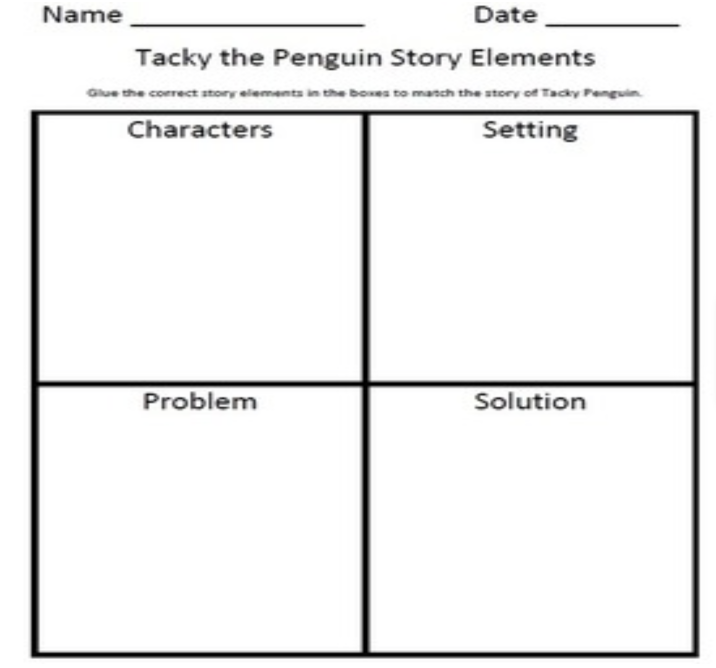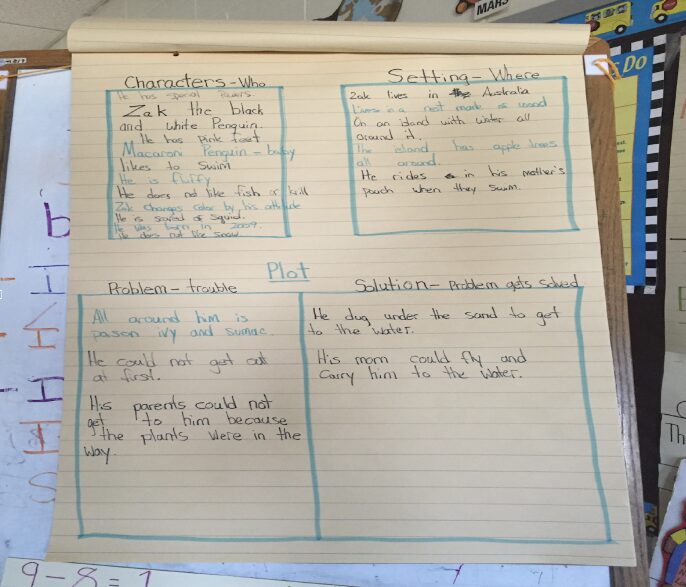Goal:
To create a fictional story using characters, setting, problem, and solution following a standard story pattern using beginning, middle, and end.
Specific Learning Objectives:
- Students will later write a pre-draft story as a reference point for comparison.
- Students will learn how to fill in details on specific story elements using a story map graphic organizer.
Students will complete a story map with details regarding characters, setting, problem, and a matching solution. - Students will use their story map and develop good sentences to express what they have from the map to create a draft copy.
Students will learn to edit for punctuation, spelling, and word choices. - Students will be able to publish a finished copy of their story for an online class book.
Prior to the Lesson:
Before the lesson, the students will have written their own penguin stories without much background assistance for later comparison to what they write after completing several steps and following a specific writing process.
Introduction/ Hook:
Watch the video on story elements:
After reading Tacky the Penguin, have a discussion about the elements of the story and talk about what made it exciting. We will note the descriptions used in the story for characters and setting and write them down on a story map on a dry-erase board. The child will talk about what details from the story gave the reader a clear picture of the characters and setting, remembering keywords in the text that helped the most. Do the same for the problem and solution. Then, discuss what you came up with together. Refer back to the story elements map and discuss each one.

Day 2
Present YouTube video on story elements:
Write a story map from scratch about a penguin. Time will be spent on each element of our story. Get excited about the details they add and encourage using their imagination. Ask follow-up questions about details to create engagement and excitement for the coming project. Let the child know that they will publish their own book and that the first step to writing is organizing our interesting details about the characters, setting, problem, and solution. The person leading the lesson does their own writing with the child to show an example of the thought process. Make sure you think out loud to display the writer’s mind. Students will try to complete their story maps for a story they will write. Ask about details, answer questions, and continue to model, adding imaginative and creative details.
Day 3
Take just the character and setting from the story map you did and create full sentences with lots of exciting details and good word choices. During this lesson, organize a good beginning to the story that paints a good picture for the reader of what our character and setting look like, sound like, and feel like (Having a discussion about the five senses beforehand is a good idea). Discuss word choice and improve the use of more enjoyable and exciting words. Discuss the importance of reading the writing as you write more so that it makes sense and to know what comes next. Intentionally write things that don’t make sense in the example writing you are modeling to bring the point home and let them point out your mistakes. They will try to write their character and setting sentences from their story maps. Share and celebrate great descriptions at the end of the writing session.
Day 4
Follow the same process for problem and solution on day 3.
Day 5
Edit the writing and fix mistakes with spelling and punctuation. Make sure to discuss editing as a positive aspect of the writing process. Make mistakes in the modeling example you are using and make mistake-fixing fun. Children will learn to take more chances when mistakes are not seen negatively but as a path to becoming a better writer. Publish your child’s work from the rough draft after the needed changes are corrected. Students will publish completed work in a book format. Make a big deal about creating their book. Laminate the pages if you like and include artwork your child completes. Building a library of published writing and encouraging your child to read it out loud to themselves and other family members elevates their self-esteem and encourages them to enjoy writing.

